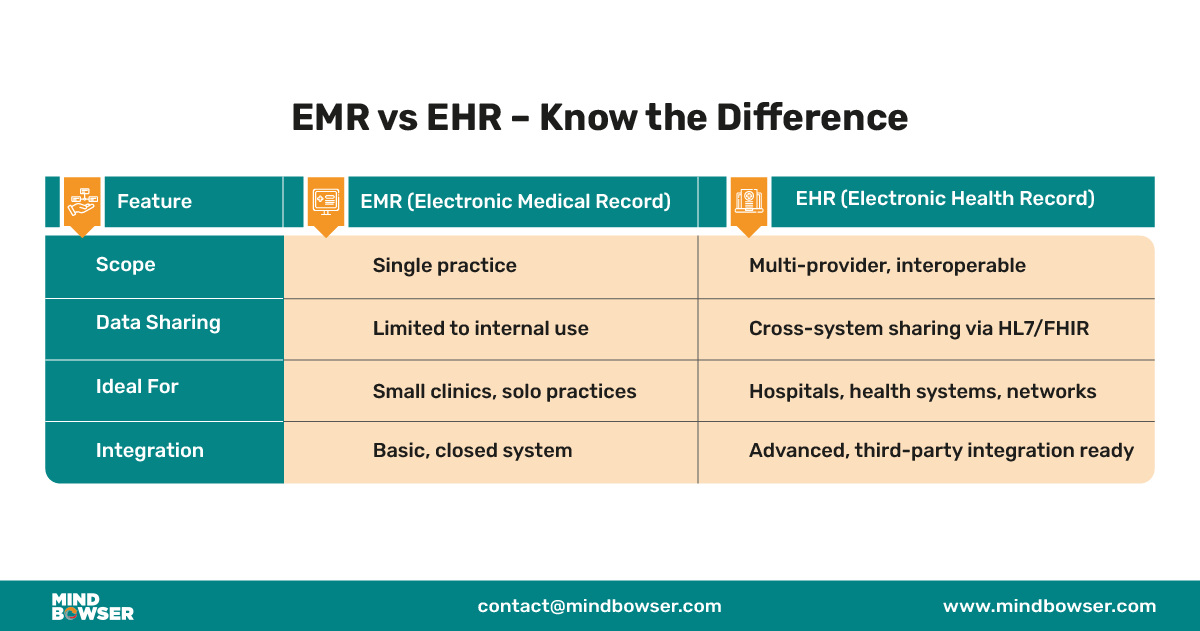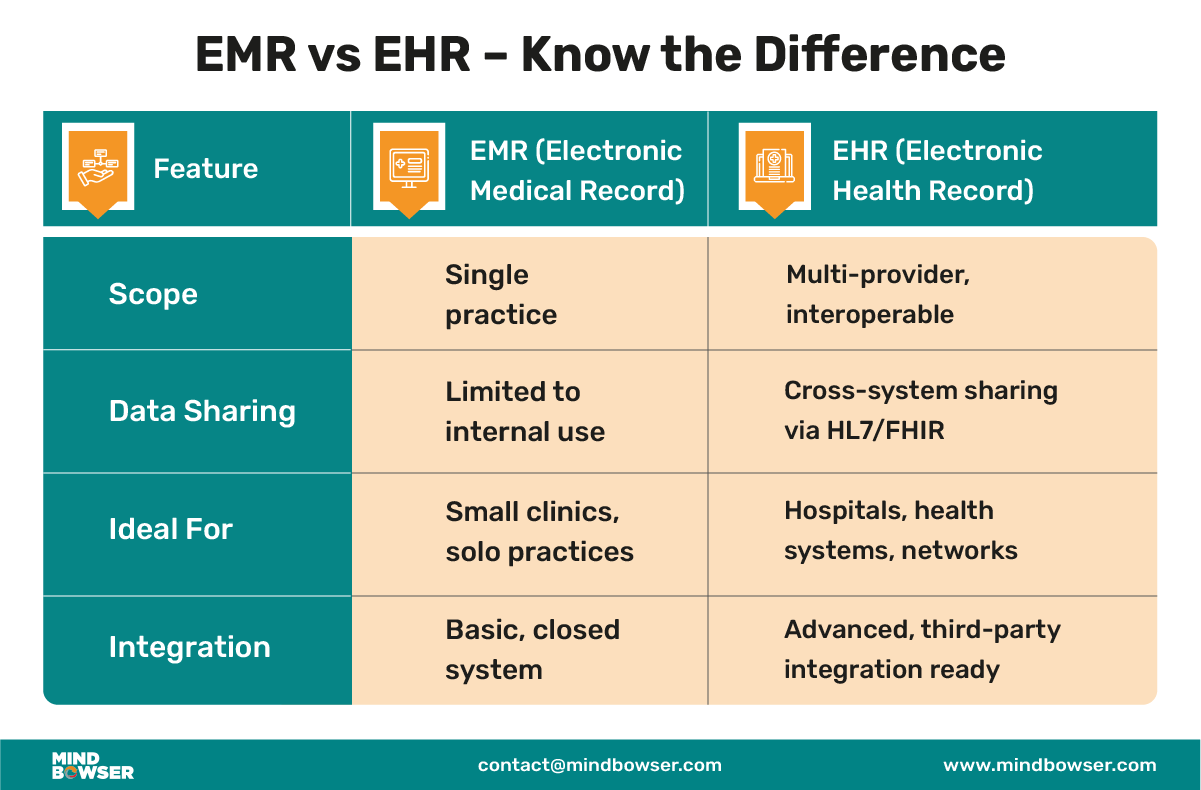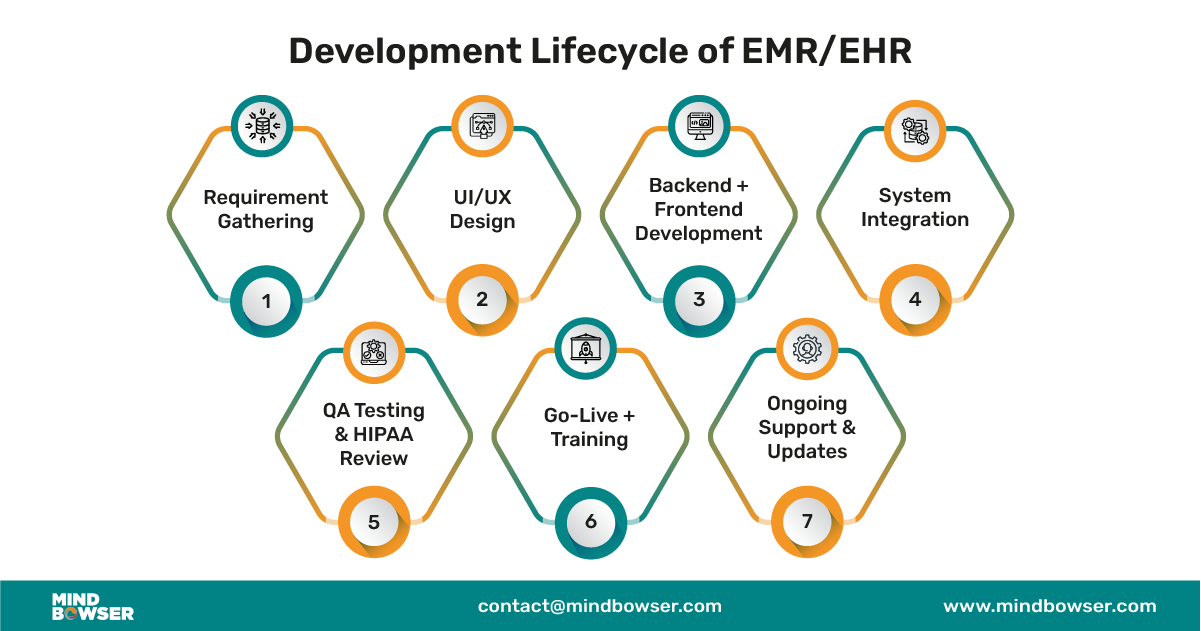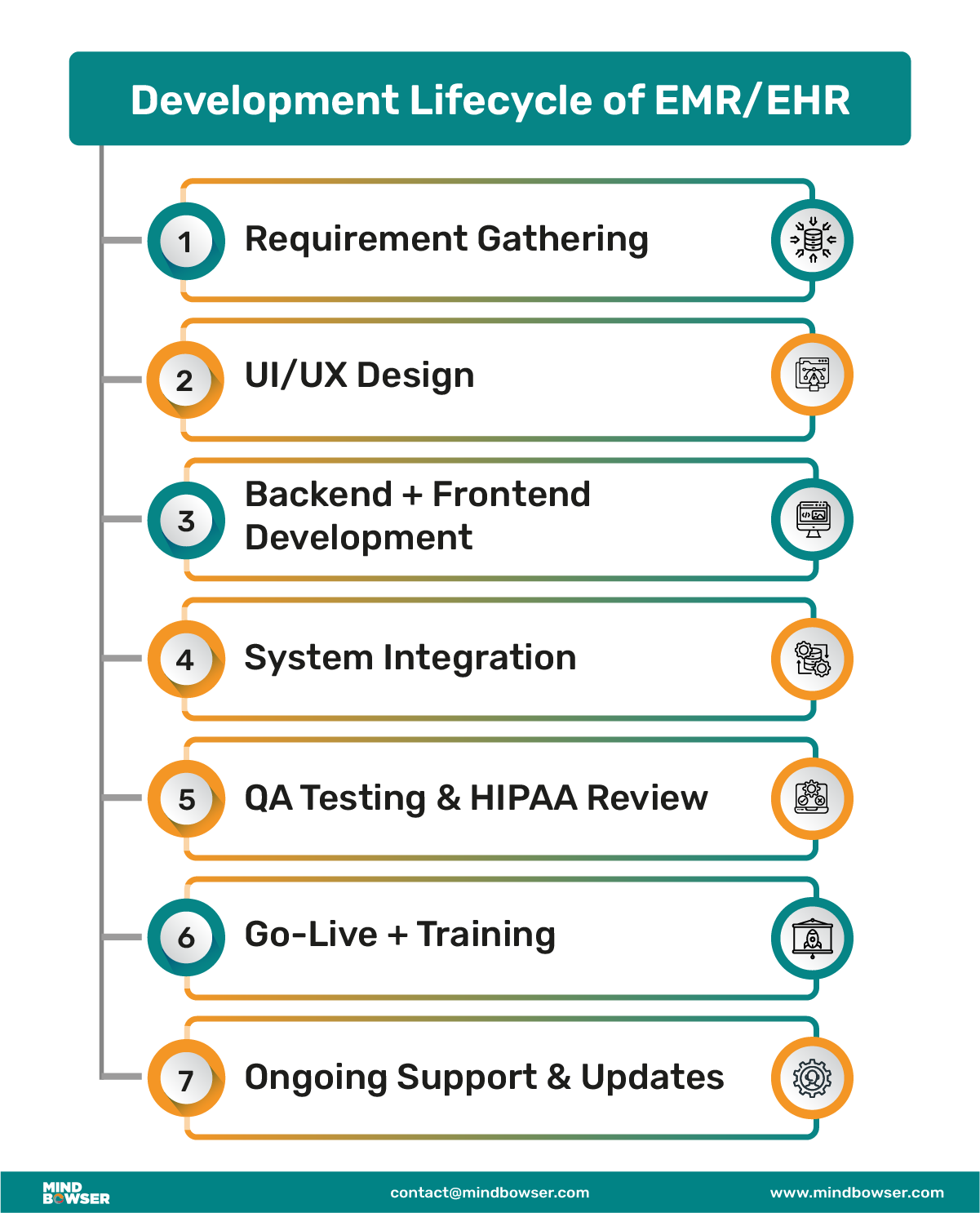Custom EMR/EHR software development services help healthcare providers build digital systems that fit their exact clinical, administrative, and compliance needs. Electronic Medical Records (EMR) typically contain a patient’s medical history within a single practice, while Electronic Health Records (EHR) offer a broader view, sharing data across different providers. Both systems improve charting accuracy, reduce paperwork, and centralize patient information, but custom-built solutions take this a step further, designed to align directly with a healthcare organization’s specific workflows and specialties.
Off-the-shelf software often forces hospitals and clinics to adjust their processes to fit the tool, which leads to inefficiencies. A custom EMR/EHR solution supports better patient experiences, faster decision-making, and easier compliance with HIPAA and other regulatory frameworks. As per the Office of the National Coordinator for Health Information Technology (ONC), 88% of office-based physicians and nearly 96% of non-federal acute care hospitals in the U.S. use some form of certified EHR system. Yet, many still face limitations due to rigid templates and poor integration. Custom development addresses these gaps, helping providers offer care that’s both efficient and personal.
Electronic Medical Records (EMR) and Electronic Health Records (EHR) are often used interchangeably, but they’re not the same.
🔸 EMR refers to the digital version of a patient’s chart, typically used within one practice.
🔸 EHR, on the other hand, is a broader system designed to share health information across multiple healthcare providers and organizations.
In short, EMR is practice-specific, while EHR is patient-centric and interoperable.


EMR works well for:
🔸 Private practices with no need to share data externally
🔸 Clinics focused on internal documentation and record-keeping
🔸 Specialty medical providers (e.g., dermatology, chiropractic)
EHR is ideal for:
🔸 Multi-specialty hospitals or care networks
🔸 Home healthcare and remote monitoring
🔸 Telehealth platforms requiring third-party integrations
🔸 Organizations participating in value-based care models
In Custom EMR/EHR Software Development Services, starting with the distinction between EMR and EHR is critical. This decision affects everything from backend architecture to compliance workflows and long-term scalability. Whether you’re building a digital record system for a single-practice clinic or a hospital-wide platform that supports data exchange, defining the right model upfront ensures smoother development and fewer compromises later.
EHRs are designed for interoperability and real-time data sharing across multiple providers, facilities, and health systems. They follow standards like HL7 and FHIR, allowing seamless exchange of patient data while supporting collaborative care. If your goal is to integrate with labs, pharmacies, or external systems, custom EHR development is the right path to meet compliance needs and ensure future-ready care delivery.
When hospitals and providers invest in custom EMR/EHR software development services, their chosen features make all the difference. Here’s a breakdown of must-have modules that power clinical efficiency and patient satisfaction.
This is the backbone of any EMR/EHR system.
🔸 Store and update patient records in real-time
🔸 Access demographic data, visit history, vitals, and allergies in one place
🔸 Enable easy handoff between departments without duplicating effort
Custom solutions can tailor these modules to reflect your specific workflows for primary care, pediatrics, or rehab centers.
Say goodbye to manual calendars and missed appointments.
🔸 Built-in scheduler that syncs with provider availability
🔸 Automated reminders via SMS, email, or app notifications
🔸 Waitlist and rebooking options for canceled slots
Smart scheduling improves patient flow and boosts clinic revenue by reducing no-shows.
No more paper slips or pharmacy miscommunication.
🔸 Directly send prescriptions to partnered pharmacies
🔸 Get real-time alerts for drug interactions and dosage conflicts
🔸 Track refill history and prescription compliance
With custom ePrescribing modules, you ensure safety, speed, and traceability at every step.
Speed up diagnosis with integrated lab communication.
🔸 Receive test orders and results inside the EMR
🔸 Flag abnormal values for immediate review
🔸 View lab trends over time for better clinical decisions
Custom integration lets you connect with your preferred labs while maintaining data standards.
Automated billing reduces errors and speeds up reimbursement.
🔸 Generate claims aligned with patient records and treatment logs
🔸 Track insurance eligibility and co-pays in real-time
🔸 Integrate with clearinghouses and payers for faster processing
Custom billing modules also help you stay ICD-10, CPT, and HIPAA compliant from day one.
Turn your data into decisions.
🔸 Visual dashboards for key performance indicators (KPIs)
🔸 Customizable filters by provider, department, or condition
🔸 Export-ready reports for audits, compliance, and board meetings
With analytics baked into your EMR/EHR, you spot bottlenecks and opportunities faster.
Related Read: Benefits and Challenges of The Electronic Health Record
Creating a custom EMR/EHR system goes beyond writing code—it’s about aligning technology with clinical workflows, regulatory needs, and patient care goals. Here’s how the development process typically unfolds:
The first step is deep diving into your current processes and future needs.
🔸 We meet with clinical, admin, and IT teams to understand what’s working and what’s not.
🔸 Key areas explored include patient flow, data formats, integrations, compliance expectations, and user roles.
🔸 This phase results in a clear requirements document that guides the rest of the project.
Goal: Build what you need, not just what sounds good in a pitch.
The best EMR/EHR system is one that people use willingly and effectively.
🔸 Our design team creates wireframes and clickable prototypes.
🔸 We prioritize clean layouts, intuitive navigation, and role-based dashboards.
🔸 Accessibility and device responsiveness are built into the UI from day one.
Result: Interfaces that reduce training time and make daily tasks faster.


Behind every smooth front-end is a powerful, secure backend.
🔸 We build scalable architecture using modern tech stacks (Node.js, .NET, etc.).
🔸 Data is structured for quick access and interoperability—think FHIR/HL7 readiness.
🔸 Security protocols like role-based access, data encryption, and audit trails are implemented from the ground up.
Outcome: A fast, compliant system that supports future integrations.
You shouldn’t have to abandon what’s already working.
🔸 We connect your new EMR/EHR with labs, billing systems, patient portals, wearables, and more.
🔸 Integration is done using secure APIs, custom connectors, or HL7/FHIR-based middleware.
🔸 We also ensure bi-directional data flow where needed.
Why it matters: Seamless data sharing reduces duplication and boosts efficiency.
No shortcuts here—healthcare systems demand reliability.
🔸 We conduct unit, system, and end-to-end testing across devices and user roles.
🔸 QA includes both automated test scripts and manual validation with real-world clinical scenarios.
🔸 Any issues found are logged, fixed, and retested until performance is solid.
Guarantee: A system that works as expected, with zero surprises post-launch.
A smooth launch is as important as the build itself.
🔸 We plan a phased rollout or full deployment, depending on your readiness.
🔸 Staff get hands-on training, quick-start guides, and video tutorials.
🔸 Ongoing support ensures questions are answered fast, even after go-live.
End Result: Confident users, minimal downtime, and fast adoption.
Related Read: Choosing Between Ready-Made and Custom EHR Solutions
Custom EMR/EHR software development services must prioritize data security and regulatory compliance from day one. Patient health data is among the most sensitive information; mishandling it can lead to severe legal and financial consequences. Here’s what healthcare providers and tech partners need to focus on:
HIPAA isn’t just a checkbox—it defines how electronic health information should be created, stored, accessed, and shared.
🔸 Every module that handles PHI (Protected Health Information) must follow the Privacy Rule and Security Rule.
🔸 Systems must support role-based access, user authentication, audit logs, and breach notifications.
🔸 Partners involved in data processing should sign Business Associate Agreements (BAAs) to ensure shared compliance responsibilities.
For deeper insights, check our detailed HIPAA compliance guide.
Whether it’s in transit or at rest, data encryption is non-negotiable.
🔸 AES-256 encryption is used for stored data, and TLS protocols are used for data in motion.
🔸 Ensure multi-factor authentication (MFA) for all EMR/EHR platform users.
🔸 Enable automatic session timeouts, IP whitelisting, and device restrictions to minimize unauthorized access.
Security needs to be proactive, not reactive.
Compliance isn’t a one-time task. It demands ongoing monitoring and updates to stay aligned with evolving regulations.
🔸 Conduct regular internal security audits and risk assessments.
🔸 Keep software up to date with patch management to address new threats.
🔸 Have a structured incident response plan to manage breaches if they occur.
Regulations change, and so do threats. Your EMR/EHR solution should be built with future compliance in mind and ready to adapt.
One of the key advantages of custom EMR/EHR software development services is the ability to integrate with your existing tools and platforms. A well-integrated system ensures smoother workflows, less manual data entry, and better decision-making.
Your EHR should work like part of your ecosystem, not in isolation.
🔸 Integrate with lab systems, radiology tools, pharmacy portals, and billing software.
🔸 Support for FHIR, HL7, and CCDA standards enables seamless connectivity with external healthcare systems.
🔸 Make interoperability a priority to improve care coordination and reduce redundancies.
APIs are the backbone of scalable and connected healthcare platforms.
🔸 Build secure, well-documented APIs to enable real-time data sharing between systems.
🔸 Allow developers to extend functionality with third-party services or custom front ends.
🔸 Enable bi-directional data flow between EMR/EHR and other apps like patient portals or scheduling tools.
Whether for wearables or partner systems, clean APIs reduce integration headaches.
Care teams are not always behind desks. Mobile integration brings flexibility without compromising data integrity.
🔸 Allow physicians and nurses to access patient records, update charts, or receive alerts from any device.
🔸 Build HIPAA-compliant mobile interfaces for clinical staff, administrative users, and patients.
🔸 Use native or hybrid apps with built-in features like offline access, push notifications, and biometric login.
Mobility turns your EMR/EHR into a tool that supports care delivery anywhere, anytime.
Related Read: Different Permissions and Possibilities between Epic, Cerner, Athenahealth, and Meditech
Investing in custom EMR/EHR software development services can seem like a big commitment, but the long-term value often outweighs the initial cost. Understanding the key factors influencing pricing helps you plan better and get more from your investment.
Not all EMR/EHR platforms are created equal, and neither are their budgets.
🔸 Scope of features: More complex functionalities like ePrescribing, billing automation, or AI-driven insights will raise development time and cost.
🔸 Integration needs: Connecting with legacy systems or third-party APIs (e.g., labs, pharmacies, insurance) adds time and testing effort.
🔸 Compliance requirements: Building HIPAA-compliant infrastructure and conducting security audits are essential, but increase upfront costs.
🔸 Custom UI/UX design and mobile support influence pricing depending on your user base and workflows.
The more tailored the system, the more precise your cost planning needs to be.
What you pay now saves time and resources later.
🔸 Custom systems reduce manual errors, data duplication, and redundant tasks.
🔸 Automated workflows lead to faster charting, better billing, and quicker reimbursements.
🔸 Integrating existing platforms saves staff from switching between tools and reduces training time.
Over time, these improvements translate to measurable cost savings.
A well-built EMR/EHR solution is not an expense—it’s an asset.
🔸 Track ROI by measuring productivity improvements, revenue cycle efficiency, and patient satisfaction scores.
🔸 Factor in reduced third-party licensing fees or subscription costs if replacing off-the-shelf systems.
🔸 Better data insights also support stronger clinical outcomes, directly impacting value-based care reimbursements.
Your ROI begins when your system aligns with your workflow and grows as your practice scales.
Every healthcare provider operates differently. A mental health clinic, a pediatric group, and a multi-specialty hospital don’t share the same workflows and shouldn’t share the same software.
Custom-built EMR/EHR systems allow providers to:
🔸 Map software logic to their exact care delivery models
🔸 Automate repetitive tasks like intake forms and chart updates
🔸 Customize dashboards for roles like physicians, nurses, and admin staff
This means less friction during daily use, fewer workarounds, and higher team efficiency.
Fragmented tools delay decisions. A custom EMR/EHR solution connects the dots by integrating everything in one place:
🔸 Lab systems
🔸 Imaging platforms
🔸 Billing portals
🔸 Telehealth tools (e.g., Doxy.me, Amwell)
🔸 Wearables and remote monitoring APIs (e.g., Dexcom API, Apple Health)
The result? Real-time insights, faster diagnoses, and a smoother experience for clinicians and patients.
Off-the-shelf systems often carry unnecessary compliance risks due to limited configuration options. With a custom EMR/EHR system, data security is built into the foundation:
🔸 Role-based access and audit trails
🔸 End-to-end encryption
🔸 HIPAA, HL7, and FHIR-compliant architecture
🔸 Secure cloud infrastructure (e.g., AWS, GCP)
You control where data lives, who can access it, and how it’s used.
As your organization grows, adding new locations, departments, or services, your software needs to scale. A custom EMR/EHR system supports:
🔸 Multi-facility management
🔸 New specialty modules
🔸 Workflow updates without starting from scratch
🔸 Interoperability with emerging tools and APIs
It’s an investment that evolves with your practice, not one that holds you back.
Related Read: Choosing Between Ready-Made and Custom EHR Solutions
The success of your custom EMR/EHR software development services hinges on who builds it. Choosing a partner with the right mix of healthcare experience, technical skill, and long-term support can make or break your project.
Healthcare is complex, and your development partner should know that firsthand.
🔸 Look for teams with real-world experience in building HIPAA-compliant applications.
🔸 Ask about previous work involving EHRs, telemedicine, patient engagement, and HL7/FHIR integration.
🔸 At Mindbowser, we’ve built solutions for providers, startups, and payers across the U.S. healthcare system.
Building is one part; maintaining and scaling is another.
🔸 Ensure the team can manage cloud infrastructure, security protocols, and interoperability standards.
🔸 Look for partners who offer ongoing support, not just launch-and-leave services.
🔸 Our team includes AWS-certified architects, health-tech engineers, and dedicated support teams for each project phase.
Results speak louder than promises.
🔸 Ask for case studies, not just portfolios.
🔸 Read testimonials from real clients working in the healthcare space.
🔸 We’ve helped digital health companies launch faster, reduce costs, and stay compliant—see how we delivered for them.
A great solution should pay off, not just solve a short-term issue.
🔸 Evaluate how the custom EMR/EHR will improve workflow efficiency, reduce manual tasks, and cut operational costs.
🔸 Consider the long-term impact on patient outcomes, revenue cycle management, and staff productivity.
Mindbowser helps clients optimize development costs and align solutions with their business goals.

Custom EMR/EHR software development services allow healthcare providers to build systems that align with their workflows, specialties, and long-term goals. Unlike off-the-shelf solutions often have limitations, custom platforms support specific needs like wearable API integrations, mobile access, HIPAA compliance, and more, ensuring better outcomes for clinicians and patients.
As healthcare evolves, investing in a tailored solution isn’t just smart—it’s necessary. A custom EMR/EHR platform allows you to scale confidently, stay compliant, and offer a user experience that works in real-world clinical settings. If you aim to build a future-ready healthcare environment, now is the time to go custom.
EMR in software development refers to electronic medical records systems that digitally store patient data, such as diagnosis, treatment history, and test results, for a single provider or clinic.
In development, EMR means building software that helps clinics digitally manage medical records, automate workflows, and maintain secure access to patient data.
EMR services include designing, developing, and maintaining electronic medical record systems for healthcare providers, focusing on features like charting, scheduling, billing, and compliance.
EMR is used within one practice and contains a digital version of paper charts. EHR goes further—it’s designed for data sharing across multiple providers and organizations for coordinated care.

We worked with Mindbowser on a design sprint, and their team did an awesome job. They really helped us shape the look and feel of our web app and gave us a clean, thoughtful design that our build team could...


The team at Mindbowser was highly professional, patient, and collaborative throughout our engagement. They struck the right balance between offering guidance and taking direction, which made the development process smooth. Although our project wasn’t related to healthcare, we clearly benefited...

Founder, Texas Ranch Security

Mindbowser played a crucial role in helping us bring everything together into a unified, cohesive product. Their commitment to industry-standard coding practices made an enormous difference, allowing developers to seamlessly transition in and out of the project without any confusion....

CEO, MarketsAI

I'm thrilled to be partnering with Mindbowser on our journey with TravelRite. The collaboration has been exceptional, and I’m truly grateful for the dedication and expertise the team has brought to the development process. Their commitment to our mission is...

Founder & CEO, TravelRite

The Mindbowser team's professionalism consistently impressed me. Their commitment to quality shone through in every aspect of the project. They truly went the extra mile, ensuring they understood our needs perfectly and were always willing to invest the time to...

CTO, New Day Therapeutics

I collaborated with Mindbowser for several years on a complex SaaS platform project. They took over a partially completed project and successfully transformed it into a fully functional and robust platform. Throughout the entire process, the quality of their work...

President, E.B. Carlson

Mindbowser and team are professional, talented and very responsive. They got us through a challenging situation with our IOT product successfully. They will be our go to dev team going forward.

Founder, Cascada

Amazing team to work with. Very responsive and very skilled in both front and backend engineering. Looking forward to our next project together.

Co-Founder, Emerge

The team is great to work with. Very professional, on task, and efficient.

Founder, PeriopMD

I can not express enough how pleased we are with the whole team. From the first call and meeting, they took our vision and ran with it. Communication was easy and everyone was flexible to our schedule. I’m excited to...

Founder, Seeke

We had very close go live timeline and Mindbowser team got us live a month before.

CEO, BuyNow WorldWide

Mindbowser brought in a team of skilled developers who were easy to work with and deeply committed to the project. If you're looking for reliable, high-quality development support, I’d absolutely recommend them.

Founder, Teach Reach

Mindbowser built both iOS and Android apps for Mindworks, that have stood the test of time. 5 years later they still function quite beautifully. Their team always met their objectives and I'm very happy with the end result. Thank you!

Founder, Mindworks

Mindbowser has delivered a much better quality product than our previous tech vendors. Our product is stable and passed Well Architected Framework Review from AWS.

CEO, PurpleAnt

I am happy to share that we got USD 10k in cloud credits courtesy of our friends at Mindbowser. Thank you Pravin and Ayush, this means a lot to us.

CTO, Shortlist

Mindbowser is one of the reasons that our app is successful. These guys have been a great team.

Founder & CEO, MangoMirror

Kudos for all your hard work and diligence on the Telehealth platform project. You made it possible.

CEO, ThriveHealth

Mindbowser helped us build an awesome iOS app to bring balance to people’s lives.

CEO, SMILINGMIND

They were a very responsive team! Extremely easy to communicate and work with!

Founder & CEO, TotTech

We’ve had very little-to-no hiccups at all—it’s been a really pleasurable experience.

Co-Founder, TEAM8s

Mindbowser was very helpful with explaining the development process and started quickly on the project.

Executive Director of Product Development, Innovation Lab

The greatest benefit we got from Mindbowser is the expertise. Their team has developed apps in all different industries with all types of social proofs.

Co-Founder, Vesica

Mindbowser is professional, efficient and thorough.

Consultant, XPRIZE

Very committed, they create beautiful apps and are very benevolent. They have brilliant Ideas.

Founder, S.T.A.R.S of Wellness

Mindbowser was great; they listened to us a lot and helped us hone in on the actual idea of the app. They had put together fantastic wireframes for us.

Co-Founder, Flat Earth

Mindbowser was incredibly responsive and understood exactly what I needed. They matched me with the perfect team member who not only grasped my vision but executed it flawlessly. The entire experience felt collaborative, efficient, and truly aligned with my goals.

Founder, Child Life On Call

The team from Mindbowser stayed on task, asked the right questions, and completed the required tasks in a timely fashion! Strong work team!

CEO, SDOH2Health LLC

Mindbowser was easy to work with and hit the ground running, immediately feeling like part of our team.

CEO, Stealth Startup

Mindbowser was an excellent partner in developing my fitness app. They were patient, attentive, & understood my business needs. The end product exceeded my expectations. Thrilled to share it globally.

Owner, Phalanx

Mindbowser's expertise in tech, process & mobile development made them our choice for our app. The team was dedicated to the process & delivered high-quality features on time. They also gave valuable industry advice. Highly recommend them for app development...

Co-Founder, Fox&Fork
